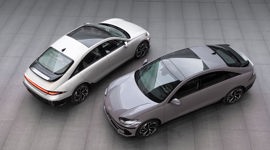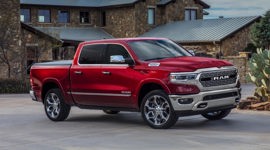It’s -15 degrees C outside the toasty cabin of the Polestar 2 I’m driving, and the track surface here at Circuit Mécaglisse, about an hour and a half north of Montreal, is sheer ice – with a nice dusting of fresh snow on top for good measure. In other words, it’s slicker than a greased pig. I also have a couple of esteemed passengers aboard this Polestar 2 Performance model, which has 469 hp and 502 lb-ft of torque.
Riding shotgun is instructor Jean-François Dumoulin who, among other accomplishments, has won the GT class of Rolex 24 Hours of Daytona behind the wheel of a Porsche 911. Twice. In the back seat rides Christian Samson. He’s the “product attributes lead” for Polestar, whose vision, passion, and engineering expertise shapes the current and future products of this new Swedish EV maker. The AWD Polestar 2 performance sedan/hatchback is the first mainstream vehicle from the brand – and Samson’s baby, which he’s very proud of.
So, no pressure, then. And no studded tires. We’re about to go flying around a skating rink.

How Did We Get Here?
But what exactly is Polestar? And why go to all the trouble of bringing us up to this frozen wonderland to slide around like Bambi and Thumper?
Before becoming Volvo’s offshoot performance-oriented EV brand, Polestar was the marque’s racing and performance division. “We are the teenager – the youthful upstart with a focus on sustainability, style, performance, and driver engagement,” Samson says.
As to why we are at Circuit Mécaglisse, Samson explains. A large part of fine-tuning the dynamics of a Polestar vehicle takes place at its frozen facility near the Arctic Circle in Sweden. “When driving on ice, everything is a bit slower, and it gives time for the human brain to understand what is happening. You come into a corner, and something happens. The car snaps a bit, and you lose the grip. You can process that better when it happens slower. When that happens at high speed on a road, there’s a lot of drama and it’s more dangerous. Doing this on ice gives us lots of time to figure out what’s happening. Was that the front roll bar? The spring rate? It helps us track it down,” he says. Essentially, testing in such extreme conditions helps Samson and his team create a better road car.

It’s My Turn to Slide
After a few introductory exercises, we select the Polestar 2’s Sport mode, which turns off stability control interference. Normally, these systems are designed to keep you safe, but when you’re trying to drift on ice, they can get in the way. By the second time around the road course, I’m managing to tie together a few YouTube-worthy (but barely controlled) drifts that miraculously don’t have us buried deep in a snowbank.
Dumoulin’s expert coaching has me Scandinavian flicking (a rally driving technique that uses oversteer and weight transfer to drive through a corner without scrubbing too much speed), and I hear a Scandinavian cheering from the back seat.
“Nice, well done!” Samson blurts as the snow flies, the derriere of the pretty Polestar makes a somewhat graceful arc, and my hands frantically saw at the wheel. Samson has spent countless hours doing this very exercise at Polestar’s northern test facility, so he knows exactly what’s going on.
As the day progresses, I’m finding I have an ace up my sleeve – besides having champion instructor Dumoulin by my side.
Samson and his team have engineered the all-wheel-drive Polestar 2 EV to have a balance and dynamic harmony that play perfectly into this icy exercise. The car has a friendly, playful, and delightfully analogue feel when driven at the limit. Factor in the EV’s low centre of gravity, natural steering feel, perfectly linear power delivery (no gears, no turbos, no waiting), and its one-pedal driving mode that enables quick transition of weight to the front wheels without touching the brake pedal, and we have a chic Swede that drives confidently on ice.

What’s Coming From Polestar?
Samson notes that the Polestar 2 (starting at about $54,000 in Canada) will be the least expensive car the brand builds. It’s all uphill from here, and he’s already working on the Polestar 7. Next up is the two-row Polestar 3 SUV, which is based on the upcoming three-row electric 2024 Volvo EX90. The Polestar 4 will be a crossover, and the 5 looks to be a very sexy Porsche Panamera-like GT luxury flagship saloon. The Polestar 6 EV Roadster launches sometime in 2026 with an 884-hp, 663 lb-ft dual-motor all-wheel-drive powertrain that it shares with the Polestar 5. Polestar 7? We’ll have to wait and see.
Samson brought a special guest over with him from Sweden: the one-off Polestar 2 Arctic Circle. Developed by trophy-winning rally driver and Polestar 2 chief chassis engineer Joakim Rydholm, this winter rally-inspired special edition features a raised suspension with unique Öhlins dampers and springs tuned to be 30 per cent softer than the road cars. The 19-inch OZ Racing wheels wear studded tires, and, of course, the Arctic Circle model runs with the 469-hp performance drivetrain. The only feature this drift-queen lacks is a windshield wiper for the driver’s side window.
A few laps behind the wheel of this uber-cool rig showed that it was more controllable at the limit and marginally grippier than the regular cars on snow tires. As Dumoulin explained, studded tires work best on sheer ice. The fresh snow on top of the ice negated their advantage. But what a blast. And a great way to elevate your heart rate.

Only five years young, Polestar is building a niche, high-style, and high-performance EV brand. Samson knows it’s a long game, but by all the pickled herring in Sweden, the man loves his job.
“Polestar is not for everybody. It is very pure, minimalistic, and honest, and this translates to the diving experience,” he says. “We want to create vehicles that inspire the type of brand passion we see with Porsche and Tesla.”



















